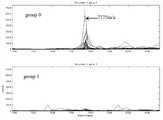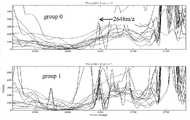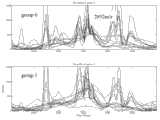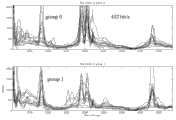CN103323518A - Method for modeling and analyzing protein fingerprinting of advanced colorectal cancer and kit - Google Patents
Method for modeling and analyzing protein fingerprinting of advanced colorectal cancer and kitDownload PDFInfo
- Publication number
- CN103323518A CN103323518ACN2013102057673ACN201310205767ACN103323518ACN 103323518 ACN103323518 ACN 103323518ACN 2013102057673 ACN2013102057673 ACN 2013102057673ACN 201310205767 ACN201310205767 ACN 201310205767ACN 103323518 ACN103323518 ACN 103323518A
- Authority
- CN
- China
- Prior art keywords
- colorectal cancer
- chemotherapy
- protein
- serum
- regimen
- Prior art date
- Legal status (The legal status is an assumption and is not a legal conclusion. Google has not performed a legal analysis and makes no representation as to the accuracy of the status listed.)
- Pending
Links
- 108090000623proteins and genesProteins0.000titleclaimsabstractdescription50
- 102000004169proteins and genesHuman genes0.000titleclaimsabstractdescription49
- 206010009944Colon cancerDiseases0.000titleclaimsabstractdescription41
- 208000001333Colorectal NeoplasmsDiseases0.000titleclaimsabstractdescription40
- 238000000034methodMethods0.000titleabstractdescription14
- 102000004506Blood ProteinsHuman genes0.000claimsabstractdescription44
- 108010017384Blood ProteinsProteins0.000claimsabstractdescription44
- 238000009104chemotherapy regimenMethods0.000claimsabstractdescription31
- 238000002512chemotherapyMethods0.000claimsabstractdescription25
- JYEFSHLLTQIXIO-SMNQTINBSA-Nfolfiri regimenChemical compoundFC1=CNC(=O)NC1=O.C1NC=2NC(N)=NC(=O)C=2N(C=O)C1CNC1=CC=C(C(=O)N[C@@H](CCC(O)=O)C(O)=O)C=C1.C1=C2C(CC)=C3CN(C(C4=C([C@@](C(=O)OC4)(O)CC)C=4)=O)C=4C3=NC2=CC=C1OC(=O)N(CC1)CCC1N1CCCCC1JYEFSHLLTQIXIO-SMNQTINBSA-N0.000claimsabstractdescription25
- YXTKHLHCVFUPPT-YYFJYKOTSA-N(2s)-2-[[4-[(2-amino-5-formyl-4-oxo-1,6,7,8-tetrahydropteridin-6-yl)methylamino]benzoyl]amino]pentanedioic acid;(1r,2r)-1,2-dimethanidylcyclohexane;5-fluoro-1h-pyrimidine-2,4-dione;oxalic acid;platinum(2+)Chemical compound[Pt+2].OC(=O)C(O)=O.[CH2-][C@@H]1CCCC[C@H]1[CH2-].FC1=CNC(=O)NC1=O.C1NC=2NC(N)=NC(=O)C=2N(C=O)C1CNC1=CC=C(C(=O)N[C@@H](CCC(O)=O)C(O)=O)C=C1YXTKHLHCVFUPPT-YYFJYKOTSA-N0.000claimsabstractdescription24
- 238000001514detection methodMethods0.000claimsdescription11
- 238000004458analytical methodMethods0.000claimsdescription8
- 239000003153chemical reaction reagentSubstances0.000claimsdescription3
- 230000005477standard modelEffects0.000abstractdescription14
- 201000004569BlindnessDiseases0.000abstractdescription2
- 239000013610patient sampleSubstances0.000abstract1
- 238000011285therapeutic regimenMethods0.000abstract1
- 210000002966serumAnatomy0.000description13
- 238000011282treatmentMethods0.000description12
- GHASVSINZRGABV-UHFFFAOYSA-NFluorouracilChemical compoundFC1=CNC(=O)NC1=OGHASVSINZRGABV-UHFFFAOYSA-N0.000description8
- 229960002949fluorouracilDrugs0.000description8
- 238000012360testing methodMethods0.000description8
- 238000001802infusionMethods0.000description6
- 206010027476MetastasesDiseases0.000description5
- 201000010099diseaseDiseases0.000description5
- 208000037265diseases, disorders, signs and symptomsDiseases0.000description5
- 229940079593drugDrugs0.000description5
- 239000003814drugSubstances0.000description5
- 238000005516engineering processMethods0.000description5
- 206010028980NeoplasmDiseases0.000description4
- 201000011510cancerDiseases0.000description4
- UWKQSNNFCGGAFS-XIFFEERXSA-NirinotecanChemical compoundC1=C2C(CC)=C3CN(C(C4=C([C@@](C(=O)OC4)(O)CC)C=4)=O)C=4C3=NC2=CC=C1OC(=O)N(CC1)CCC1N1CCCCC1UWKQSNNFCGGAFS-XIFFEERXSA-N0.000description4
- 229960004768irinotecanDrugs0.000description4
- 238000004393prognosisMethods0.000description4
- 238000001356surgical procedureMethods0.000description4
- 239000012148binding bufferSubstances0.000description3
- 238000003745diagnosisMethods0.000description3
- 238000001990intravenous administrationMethods0.000description3
- 238000004949mass spectrometryMethods0.000description3
- 229960001756oxaliplatinDrugs0.000description3
- DWAFYCQODLXJNR-BNTLRKBRSA-LoxaliplatinChemical compoundO1C(=O)C(=O)O[Pt]11N[C@@H]2CCCC[C@H]2N1DWAFYCQODLXJNR-BNTLRKBRSA-L0.000description3
- 230000035945sensitivityEffects0.000description3
- 238000000672surface-enhanced laser desorption--ionisationMethods0.000description3
- 208000015634Rectal NeoplasmsDiseases0.000description2
- 230000009286beneficial effectEffects0.000description2
- 210000004369bloodAnatomy0.000description2
- 239000008280bloodSubstances0.000description2
- 229940044683chemotherapy drugDrugs0.000description2
- 230000000694effectsEffects0.000description2
- 238000011156evaluationMethods0.000description2
- 238000001914filtrationMethods0.000description2
- 238000010253intravenous injectionMethods0.000description2
- 230000003902lesionEffects0.000description2
- 239000007788liquidSubstances0.000description2
- 230000002980postoperative effectEffects0.000description2
- 206010038038rectal cancerDiseases0.000description2
- 201000001275rectum cancerDiseases0.000description2
- 239000000523sampleSubstances0.000description2
- 239000000243solutionSubstances0.000description2
- 238000000756surface-enhanced laser desorption--ionisation time-of-flight mass spectrometryMethods0.000description2
- 230000004083survival effectEffects0.000description2
- XLYOFNOQVPJJNP-UHFFFAOYSA-NwaterSubstancesOXLYOFNOQVPJJNP-UHFFFAOYSA-N0.000description2
- 102000009027AlbuminsHuman genes0.000description1
- 108010088751AlbuminsProteins0.000description1
- 206010006187Breast cancerDiseases0.000description1
- 208000026310Breast neoplasmDiseases0.000description1
- 206010052358Colorectal cancer metastaticDiseases0.000description1
- 208000002699Digestive System NeoplasmsDiseases0.000description1
- 206010061818Disease progressionDiseases0.000description1
- 102000006395GlobulinsHuman genes0.000description1
- 108010044091GlobulinsProteins0.000description1
- 206010027452Metastases to boneDiseases0.000description1
- 206010027457Metastases to liverDiseases0.000description1
- 206010027458Metastases to lungDiseases0.000description1
- 206010051676Metastases to peritoneumDiseases0.000description1
- 206010033128Ovarian cancerDiseases0.000description1
- 206010061535Ovarian neoplasmDiseases0.000description1
- 206010060862Prostate cancerDiseases0.000description1
- 208000000236Prostatic NeoplasmsDiseases0.000description1
- 208000003252Signet Ring Cell CarcinomaDiseases0.000description1
- VMHLLURERBWHNL-UHFFFAOYSA-MSodium acetateChemical compound[Na+].CC([O-])=OVMHLLURERBWHNL-UHFFFAOYSA-M0.000description1
- 239000002250absorbentSubstances0.000description1
- 230000002745absorbentEffects0.000description1
- 208000009956adenocarcinomaDiseases0.000description1
- 238000009098adjuvant therapyMethods0.000description1
- 230000000259anti-tumor effectEffects0.000description1
- 239000002246antineoplastic agentSubstances0.000description1
- 229940041181antineoplastic drugDrugs0.000description1
- 230000008901benefitEffects0.000description1
- 239000012472biological sampleSubstances0.000description1
- 239000000090biomarkerSubstances0.000description1
- KVUAALJSMIVURS-ZEDZUCNESA-Lcalcium folinateChemical compound[Ca+2].C1NC=2NC(N)=NC(=O)C=2N(C=O)C1CNC1=CC=C(C(=O)N[C@@H](CCC([O-])=O)C([O-])=O)C=C1KVUAALJSMIVURS-ZEDZUCNESA-L0.000description1
- 235000008207calcium folinateNutrition0.000description1
- 239000011687calcium folinateSubstances0.000description1
- 210000001175cerebrospinal fluidAnatomy0.000description1
- 238000004587chromatography analysisMethods0.000description1
- 208000029742colonic neoplasmDiseases0.000description1
- 238000009096combination chemotherapyMethods0.000description1
- 238000013480data collectionMethods0.000description1
- 238000013461designMethods0.000description1
- 238000010586diagramMethods0.000description1
- 238000003748differential diagnosisMethods0.000description1
- 230000005750disease progressionEffects0.000description1
- 239000000890drug combinationSubstances0.000description1
- 238000001035dryingMethods0.000description1
- 230000003862health statusEffects0.000description1
- 238000004128high performance liquid chromatographyMethods0.000description1
- 238000009169immunotherapyMethods0.000description1
- 238000011337individualized treatmentMethods0.000description1
- 230000009401metastasisEffects0.000description1
- 239000000203mixtureSubstances0.000description1
- 201000010879mucinous adenocarcinomaDiseases0.000description1
- 238000009099neoadjuvant therapyMethods0.000description1
- 230000001575pathological effectEffects0.000description1
- 238000007781pre-processingMethods0.000description1
- 230000008569processEffects0.000description1
- 238000001959radiotherapyMethods0.000description1
- 238000011160researchMethods0.000description1
- 230000004044responseEffects0.000description1
- 201000008123signet ring cell adenocarcinomaDiseases0.000description1
- 235000017281sodium acetateNutrition0.000description1
- 239000001632sodium acetateSubstances0.000description1
- 238000001228spectrumMethods0.000description1
- 238000012353t testMethods0.000description1
- 238000011269treatment regimenMethods0.000description1
- 210000002700urineAnatomy0.000description1
Images
Landscapes
- Investigating Or Analysing Biological Materials (AREA)
Abstract
Description
Translated fromChinese技术领域technical field
本发明属于恶性肿瘤检测领域,具体涉及到一种结直肠癌晚期蛋白质指纹图谱建模分析方法及试剂盒。The invention belongs to the field of malignant tumor detection, and in particular relates to a method for modeling and analyzing late stage protein fingerprints of colorectal cancer and a kit.
背景技术Background technique
结直肠癌是当今世界上最常见的肿瘤之一,其肿瘤相关死亡率居恶性肿瘤中的第三位。大多数病人在诊断时已是中晚期,失去手术机会,其主要治疗手段为化疗。由于新的化疗药物的出现,结直肠癌的治疗发生了极大的改变,这些化疗药物包括:氟脲嘧啶5-FU,亚叶酸钙CF,伊立替康, 奥沙利铂,这些药物是治疗结直肠癌的经典药物。这些药物中,两药联合化疗方案与5-FU单药方案相比,可以提高反应率和无进展生存期(PFS),还可以提高总生存(OS)。其中5-FU、CF联合奥沙利铂所组成的FOLFOX化疗方案,以及5-FU、CF联合伊立替康所组成的FOLFIRI化疗方案已经成为治疗中晚期结直肠癌的标准方案。这两种方案,作为一线方案治疗中晚期结直肠癌时,其有效率均约为40%。目前没有依据表明FOLFOX或FOLFIRI何种化疗方案更优。因此,仍有大多数病人要承受化疗失败、疾病进展的可能。而临床上对于这两种化疗方案的选择,往往基于医生个人临床经验和习惯,至今并未有明确的标记物可用来预测化疗疗效及选择适合的病人。Colorectal cancer is one of the most common tumors in the world today, and its tumor-related mortality ranks third among malignant tumors. Most of the patients are already in the middle and advanced stages when they are diagnosed, and they lose the chance of surgery, and the main treatment is chemotherapy. The treatment of colorectal cancer has changed dramatically due to the emergence of new chemotherapy drugs, including: fluorouracil 5-FU, calcium folinate CF, irinotecan, oxaliplatin, these drugs are the treatment Classic drugs in colorectal cancer. Among these drugs, the two-drug combination chemotherapy regimen can improve the response rate and progression-free survival (PFS) compared with the 5-FU single-drug regimen, and can also improve the overall survival (OS). Among them, the FOLFOX chemotherapy regimen composed of 5-FU, CF combined with oxaliplatin, and the FOLFIRI chemotherapy regimen composed of 5-FU, CF combined with irinotecan have become the standard regimen for the treatment of advanced colorectal cancer. When these two regimens are used as first-line regimens in the treatment of advanced colorectal cancer, their effective rates are about 40%. There is currently no evidence that FOLFOX or FOLFIRI is a better chemotherapy regimen. Therefore, most patients still have to bear the possibility of chemotherapy failure and disease progression. Clinically, the choice of these two chemotherapy regimens is often based on the doctor's personal clinical experience and habits. So far, there are no clear markers that can be used to predict the efficacy of chemotherapy and select suitable patients.
人类血浆几乎是能反映机体任意时刻健康状况的最完整的蛋白质源,血浆蛋白除了白蛋白、球蛋白等20余种高丰度蛋白外还含有仅占总量1%的低丰度蛋白。疾病时释放入血和对疾病诊断有重要意义的蛋白质分子多数包含在这些低丰度蛋白里面。SELDI-TOF-MS 技术应用了基因芯片的设计原理,把层析、质谱等技术合理地与蛋白质芯片相结合,融合了质谱高敏感性和蛋白质芯片高通量的特点。其最大优点是不受高丰度蛋白的干扰,可以检测到fmol(10-15 mol)数量级的低丰度蛋白质,且可一次获得成千上万的蛋白质数据,克服了过去蛋白质组学分析中的瓶颈问题。还可以直接分析原始生物样品(如血清、尿、脑脊液等)等,在临床检验中具有广泛的应用前景。Human plasma is almost the most complete protein source that can reflect the health status of the body at any time. In addition to more than 20 high-abundance proteins such as albumin and globulin, plasma proteins also contain low-abundance proteins that account for only 1% of the total. Most of the protein molecules released into the blood during disease and important for disease diagnosis are contained in these low-abundance proteins. SELDI-TOF-MS technology applies the design principles of gene chips, reasonably combines chromatography, mass spectrometry and other technologies with protein chips, and combines the characteristics of high sensitivity of mass spectrometry and high throughput of protein chips. Its biggest advantage is that it is not interfered by high-abundance proteins, can detect low-abundance proteins on the order of fmol (10-15 mol), and can obtain tens of thousands of protein data at one time, overcoming the traditional proteomics analysis. bottleneck problem. It can also directly analyze original biological samples (such as serum, urine, cerebrospinal fluid, etc.), and has broad application prospects in clinical testing.
SELDI-TOF-MS蛋白质芯片系统已广泛应用于多种恶性肿瘤的诊断,如乳腺癌 、前列腺癌、消化系统肿瘤及卵巢癌等。在结直肠癌的蛋白组学研究报道中,可见将SELDI技术用于结直肠癌的鉴别诊断、术前病理分期、预后评估及术后复发转移评估 。但对于将该技术用于结直肠癌化疗疗效预测,且分别是不同方案的预测的研究国内外鲜见报道。SELDI-TOF-MS protein chip system has been widely used in the diagnosis of various malignant tumors, such as breast cancer, prostate cancer, digestive system tumors and ovarian cancer. In the proteomics research report of colorectal cancer, it can be seen that SELDI technology is used in the differential diagnosis, preoperative pathological staging, prognosis evaluation and postoperative recurrence and metastasis evaluation of colorectal cancer. However, there are few reports at home and abroad on the application of this technology to predict the curative effect of colorectal cancer chemotherapy, and the prediction of different regimens.
随着个体化治疗时代的到来,目前认为肿瘤标记物能否作为某种治疗的疗效预测标记物,其价值要比仅用作预后判断更为重要。有许多关于结直肠癌蛋白质谱方面的研究,其中可见少数与疗效、预后相关的报道。Smith等人使用该技术对结直肠癌进行的研究中,发现直肠癌患者经新辅助治疗1-2天后血清蛋白质谱发生改变,可以区分疗效好与差的改变,敏感率为87.5%,特异性为80%。Zheng等研究发现结直肠癌患者在术后两周,其血清蛋白质谱发生微小的变化,尽管这种变化与疾病状态的具体关系仍旧不明。Christopher等人对结直肠癌手术病人术前血液进行检测,发现术后病期较晚者诊断为癌的准确性高,而病期较早的容易误诊为正常,因此认为血清蛋白图谱能判断预后,帮助制定辅助治疗方案。但这些研究仍倾向于疗效监测及预后评估,并没有直接对化疗药物疗效进行预测评估。With the advent of the era of individualized treatment, it is currently believed that whether tumor markers can be used as predictive markers for the efficacy of a certain treatment is more important than just being used for prognostic judgment. There are many studies on the protein profile of colorectal cancer, among which there are few reports related to efficacy and prognosis. Smith et al. used this technology to study colorectal cancer and found that the serum protein profile of rectal cancer patients changed after 1-2 days of neoadjuvant therapy, which can distinguish between good and bad curative effects. The sensitivity rate was 87.5%, and the specificity rate was 87.5%. 80%. Zheng et al found small changes in the serum protein profile of colorectal cancer patients two weeks after surgery, although the exact relationship between these changes and disease status remains unclear. Christopher et al. tested the preoperative blood of patients with colorectal cancer surgery and found that patients with late postoperative disease had a high accuracy in diagnosis of cancer, while those with early disease were easily misdiagnosed as normal. Therefore, they believed that the serum protein profile can judge the prognosis , to help develop an adjuvant treatment plan. However, these studies still tend to monitor efficacy and evaluate prognosis, and do not directly predict and evaluate the efficacy of chemotherapy drugs.
发明内容Contents of the invention
本发明的目的在于提出一种结直肠癌晚期蛋白质指纹图谱建模分析方法及试剂盒。The purpose of the present invention is to provide a method and kit for modeling and analyzing late stage protein fingerprints of colorectal cancer.
一种结直肠癌晚期蛋白质指纹图谱建模分析方法,包括如下步骤:A method for modeling and analyzing late stage protein fingerprints of colorectal cancer, comprising the following steps:
1)对经历过化疗方案的结直肠癌晚期患者样本,分别建立血清蛋白质指纹图谱;1) Establish serum protein fingerprints for samples from patients with advanced colorectal cancer who have undergone chemotherapy regimens;
2)对已获得的样本血清蛋白质指纹图谱提取血清蛋白质指纹特征,按化疗方案分别建立标准模型;2) Extract serum protein fingerprint features from the obtained sample serum protein fingerprints, and establish standard models according to chemotherapy regimens;
3)对未经历过化疗的结直肠癌晚期患者,建立未经历过化疗的血清蛋白质指纹图谱,提取血清蛋白质指纹特征;3) For patients with advanced colorectal cancer who have not undergone chemotherapy, establish serum protein fingerprints and extract serum protein fingerprint features;
4)将未经历过化疗的血清蛋白质指纹特征与步骤2)建立的标准模型进行对比分析。4) Compare and analyze the serum protein fingerprint characteristics of chemotherapy-naïve serum with the standard model established in step 2).
所述的化疗方案为FOLFOX或FOLFIRI。The chemotherapy regimen described is FOLFOX or FOLFIRI.
所述的FOLFOX化疗方案的血清蛋白质指纹图谱标准模型由6个蛋白质峰组成,这6个蛋白质峰的质荷比分别为3963m/z 、9281m/z、4606m/z、9198m/z、7775m/z,2266m/z;所述的FOLFIRI化疗方案的血清蛋白质指纹图谱标准模型由7个蛋白质峰组成,这7个蛋白质峰的质荷比分别为4321m/z 、 4305m/z、2648m/z、2952m/z、4292m/z、3980 m/z。The serum protein fingerprint standard model of the FOLFOX chemotherapy regimen consists of 6 protein peaks, the mass-to-charge ratios of these 6 protein peaks are 3963m/z, 9281m/z, 4606m/z, 9198m/z, 7775m/z respectively , 2266m/z; the standard model of the serum protein fingerprint of the FOLFIRI chemotherapy regimen consists of 7 protein peaks, and the mass-to-charge ratios of these 7 protein peaks are 4321m/z, 4305m/z, 2648m/z, 2952m/z, respectively. z, 4292m/z, 3980m/z.
一种所述的结直肠癌晚期蛋白质指纹图谱建模分析方法建立的试剂盒,它包括蛋白质峰的质荷比的检测试剂。A kit for establishing the method for modeling and analyzing late-stage protein fingerprints of colorectal cancer, which includes detection reagents for the mass-to-charge ratio of protein peaks.
本发明的有益效果Beneficial effects of the present invention
本方法克服了结直肠癌晚期治疗方案选择的盲目性问题。在化疗之前,对结直肠癌晚期患者进行血清蛋白质指纹图谱的检测,分析患者是FOLFOX方案的受益者还是FOLFIRI方案的受益者;根据检测分析的结果,为患者选择合适的化疗方案,这样可以为患者选择最佳治疗方案,为患者进行个性化治疗,从而节约医疗成本。This method overcomes the blindness in the selection of treatment options for advanced colorectal cancer. Before chemotherapy, detect the serum protein fingerprint of patients with advanced colorectal cancer to analyze whether the patient is a beneficiary of the FOLFOX regimen or the FOLFIRI regimen; according to the results of the detection and analysis, select the appropriate chemotherapy regimen for the patient, which can provide Patients choose the best treatment plan and provide personalized treatment for patients, thereby saving medical costs.
附图说明Description of drawings
图1是结直肠癌晚期蛋白质指纹图谱建模分析方法的实施例的流程示意图。Fig. 1 is a schematic flow chart of an embodiment of a method for modeling and analyzing protein fingerprints in advanced stages of colorectal cancer.
图2是血清蛋白质指纹图谱检测的流程图。Fig. 2 is a flowchart of serum protein fingerprint detection.
图3是FOLFOX化疗方案的血清蛋白质指纹图谱标准模型。Figure 3 is the standard model of the serum protein fingerprint of the FOLFOX chemotherapy regimen.
图3.1-图3.6中,蛋白质峰的质荷比分别为3963m/z 、9281m/z、4606m/z、9198m/z、7775m/z,2266m/z。In Figure 3.1-Figure 3.6, the mass-to-charge ratios of protein peaks are 3963m/z, 9281m/z, 4606m/z, 9198m/z, 7775m/z, and 2266m/z, respectively.
图4是FOLFIRI化疗方案的血清蛋白质指纹图谱标准模型。Figure 4 is the standard model of the serum protein fingerprint of the FOLFIRI chemotherapy regimen.
图4.1-图4.6中,蛋白质峰的质荷比分别为2648m/z、2952m/z、4321m/z、4305m/z、4292m/z,3980 m/z。In Figure 4.1-Figure 4.6, the mass-to-charge ratios of the protein peaks are 2648m/z, 2952m/z, 4321m/z, 4305m/z, 4292m/z, and 3980m/z, respectively.
具体实施方式Detailed ways
以下结合附图和具体实施例对本发明做进一步的说明。The present invention will be further described below in conjunction with the accompanying drawings and specific embodiments.
实施例Example
图1所示的是本发明的步骤流图,第一步是建立FOLFOX和FOLFIRI化疗方法的血清蛋白质指纹图谱标准模型,具体如下:Shown in Fig. 1 is the step flow diagram of the present invention, and the first step is to set up the serum protein fingerprint spectrum standard model of FOLFOX and FOLFIRI chemotherapy method, specifically as follows:
(1)标本来源 (1) Source of specimens
2008年8月~2010年7月在浙二医院(浙江大学医学院附属第二医院)接受治疗的经病理确诊为转移性结直肠癌患者共70例,有不能切除的原发灶、复发或转移的可测量病灶。所有患者均为初治患者或最近6月内未曾行化疗及其他抗肿瘤药物治疗者。其中男37例,女33例,年龄42~74岁,中位年龄60岁;结肠癌44例,直肠癌26例,高、中、低(包括黏液腺癌及印戒细胞癌)分化腺癌分别为16、30、24例;转移器官部位2处的9例, 3处以上9例; 肝转移41例, 肺转移26例, 腹膜转移9例,腹膜后转移2例,骨转移3例。70例FOLFOX或FOLFIRI方案化疗的结直肠癌患者样本中,临床受益42例,无效28例;70例患者中,44例行FOLFOX方案化疗,其中临床受益29例,无效(PD)15例;70例患者中,26例患者行FOLFIRI方案化疗,其中临床受益13例,无效13例。From August 2008 to July 2010, a total of 70 patients with metastatic colorectal cancer who were pathologically diagnosed in Zhejiang Second Hospital (The Second Affiliated Hospital of Zhejiang University School of Medicine) had unresectable primary lesions, recurrence or Measurable lesions of metastases. All patients were treatment-naïve patients or those who had not received chemotherapy and other anticancer drugs in the last 6 months. Among them, there were 37 males and 33 females, aged 42-74 years, with a median age of 60 years; 44 cases of colon cancer, 26 cases of rectal cancer, high, medium and low (including mucinous adenocarcinoma and signet ring cell carcinoma) differentiated adenocarcinoma 16, 30, and 24 cases respectively; 9 cases with 2 metastases, 9 cases with more than 3 metastases; 41 cases with liver metastases, 26 cases with lung metastases, 9 cases with peritoneal metastases, 2 cases with retroperitoneal metastases, and 3 cases with bone metastases. Among 70 samples of colorectal cancer patients treated with FOLFOX or FOLFIRI regimen chemotherapy, 42 cases were clinically benefited and 28 cases were ineffective; among the 70 patients, 44 cases received FOLFOX regimen chemotherapy, of which 29 cases were clinically benefited and 15 cases were ineffective (PD); 70 Among the patients, 26 patients received FOLFIRI chemotherapy, of which 13 patients were clinically beneficial and 13 patients were ineffective.
化疗期间不采用其他抗肿瘤治疗方式,包括放疗、手术、免疫治疗。经本院伦理委员会同意,所有病人签署知情同意书。During chemotherapy, no other anti-tumor treatment methods, including radiotherapy, surgery, and immunotherapy, were used. All patients signed an informed consent form approved by the Ethics Committee of our hospital.
(2)化疗方案(2) Chemotherapy regimen
FOLFOX或FOLFIRI方案化疗4次(2疗程)Chemotherapy with FOLFOX or FOLFIRI regimen 4 times (2 courses)
FOLFOX方案:奥沙利铂85mg/m2,静脉滴注2小时,第一天;CF 400 mg/m2,静脉滴注2小时,第一天;5-FU 400 mg/m2静脉推注,第一天,然后1200 mg/m2/d×2天,(总量2400mg/m2,滴注46~48小时)。FOLFOX regimen: oxaliplatin 85mg/m2, intravenous infusion for 2 hours, the first day;
FOLFIRI方案:伊立替康180 mg/m2 静脉滴注30~90分钟,第1天;CF 400 mg/m2 与伊立替康同时滴注,第1天,5-FU 400 mg/m2静脉推注,第1天,然后5-FU 1200 mg/m2/d×2天(总量2400mg/m2,滴注46~48小时)。FOLFIRI scheme: irinotecan 180 mg/m2 intravenous infusion for 30-90 minutes, on the first day;
(3)对标本做血清蛋白质指纹图谱检测(3) Serum protein fingerprint detection on the specimen
图2所示为血清蛋白质指纹图谱检测的流程图,主要的操作为:Figure 2 shows the flow chart of serum protein fingerprint detection, the main operations are:
1、 芯片的预处理芯片装入96孔芯片工作支架Bio-processor中,每孔中加入Binding Buffer:200μl 50mM 乙酸钠 (pH=4.0)室温,600rpm,振荡5分钟使充分平衡后去除液体,并重一次。1. Chip pretreatment: put the chip into the 96-well chip working bracket Bio-processor, add Binding Buffer to each well: 200μl 50mM sodium acetate (pH=4.0) at room temperature, 600rpm, shake for 5 minutes to fully balance, remove the liquid, and weigh again once.
2、血清的预处理血清置冰上缓慢融解,4℃、10000rpm离心5分钟;5ul血清中加入10μl U9血清处理液,4℃、600rpm振荡使充分混合;加入Binding Buffer将U9处理后的血清稀释至200μl,4℃、600rpm振荡使充分混合。2. Serum pretreatment Serum was slowly melted on ice, centrifuged at 4°C and 10,000rpm for 5 minutes; 10μl U9 serum treatment solution was added to 5ul of serum, shaken at 4°C and 600rpm to fully mix; add Binding Buffer to dilute the U9-treated serum to 200 μl, shake at 4°C and 600 rpm to mix thoroughly.
3、蛋白质与芯片结合3. Binding of protein to chip
取上述稀释过的血清100μl点样于芯片上,并去除每孔中的气泡;4℃、600rpm振荡1小时,芯片与血清充分反应。Take 100 μl of the above-mentioned diluted serum and apply it on the chip, and remove the air bubbles in each well; shake at 4°C and 600 rpm for 1 hour, and the chip fully reacts with the serum.
4、结合后冲洗4. Rinse after combination
每孔加入200μl相应的Binding Buffer,室温、600rpm振荡5分钟后除去液体重复该过程2次;纯度HPLC级水200μl快速清洗每个孔2次,甩干并将Bio-processor倒扣在吸水纸上轻拍去除多余的水。将芯片从Bio-processor自然干燥。Add 200μl of the corresponding Binding Buffer to each well, shake at room temperature and 600rpm for 5 minutes, remove the liquid and repeat the process twice; 200μl of pure HPLC grade water quickly wash each well twice, dry and place the Bio-processor upside down on absorbent paper Gently tap to remove excess water. Dry the chip naturally from the Bio-processor.
5、点加能量吸收分子(EAM)5. Add Energy Absorbing Molecule (EAM)
每孔加入50%饱和的SPA溶液1μl,自然干燥后重复加样1次。自然干燥并上机检测。Add 1 μl of 50% saturated SPA solution to each well, and repeat the addition once after natural drying. Dry naturally and test on the machine.
6、SELDI质谱仪参数设置6. SELDI mass spectrometer parameter setting
标准蛋白质芯片All-in-One矫正SELDI质谱系统的分子量误差到<0.1%;待测蛋白质的芯片检测参数设置:激光强度为165,检测灵敏度7,检测上限60,000m/z,优化收集数据范围2000~30000 m/z,信号收集位置从20~80,每个样本取120个点所收集信号的平均值。The standard protein chip All-in-One corrects the molecular weight error of the SELDI mass spectrometry system to <0.1%; the chip detection parameter settings of the protein to be tested: the laser intensity is 165, the detection sensitivity is 7, the detection limit is 60,000m/z, and the optimized data collection range is 2000 ~30000 m/z, the signal collection position ranges from 20 to 80, and the average value of the signals collected at 120 points is taken for each sample.
7、数据预处理7. Data preprocessing
先以Proteinchip Software 3.2软件校正原始数据,使总离子强度和分子量达到均一,过滤噪音,设初始噪音过滤值5(信号/噪音,Signal/Noise,S/N),二次噪音过滤值2,按10%为最小阈值聚类。之后用t检验或Mann-Whitney秩和检验比较各组血清蛋白质指纹图谱数据(由Proteinchip Software 3.2自带的Biomarker Wizard 3.1软件完成),寻找各组之间表达差异的蛋白质峰。First use Proteinchip Software 3.2 to correct the original data, so that the total ionic strength and molecular weight are uniform, and filter the noise. Set the initial noise filtering value to 5 (signal/noise, Signal/Noise, S/N), and the secondary noise filtering value to 2, press 10% is the minimum threshold for clustering. Then use the t test or Mann-Whitney rank sum test to compare the serum protein fingerprint data of each group (completed by the Biomarker Wizard 3.1 software that comes with Proteinchip Software 3.2), and look for protein peaks with differences in expression among the groups.
(4)结果分析与建模(4) Result analysis and modeling
对70个样本进行的血清蛋白质指纹图谱检测,分析检测结果发现:在44例接受FOLFOX化疗方案的患者中,29例受益者与15例无效者的血清蛋白质指纹图谱中,有6个蛋白质峰(这6个蛋白质峰的质荷比分别为3963m/z 、9281m/z、4606m/z、9198m/z、7775m/z,2266m/z)差异很大,其中3963 m/z、9282 m/z、4606m/z、9198m/z、7775m/z这5个峰在FOLFOX方案化疗的结直肠癌患者化疗受益者血清中表达高于无效者;2266m/z蛋白质峰在FOLFOX方案化疗的晚期结直肠癌患者化疗受益者血清中表达低于无效者,分别如图3.1到图3.6所示(group 0为受益者,group 1为无效者);26例接受FOLFIRI化疗方案的患者样本中,13例受益者与13例无效者的血清蛋白质指纹图谱对比发现有7个蛋白质峰(这7个蛋白质峰的质荷比分别为4321m/z 、 4305m/z、2648m/z、2952m/z、4121m/z,4292m/z,3980 m/z)差异很大,其中2648m/z,2952m/z,4121m/z这三个峰在FOLFIRI方案化疗的结直肠癌患者化疗受益者血清中表达低于无效者;4321 m/z、4305 m/z、4292 m/z、3980m/z这4个峰在FOLFIRI方案化疗的结直肠癌患者化疗受益者血清中表达高于无效者,分别如图4.1到图4.6所示(group 0为受益者,group 1为无效者)。 The serum protein fingerprints of 70 samples were detected, and the results of the analysis found that among the 44 patients who received FOLFOX chemotherapy, there were 6 protein peaks in the serum protein fingerprints of 29 beneficiaries and 15 ineffective patients ( The mass-to-charge ratios of these six protein peaks are 3963m/z, 9281m/z, 4606m/z, 9198m/z, 7775m/z, and 2266m/z) with great differences, among which 3963m/z, 9282m/z, The 5 peaks of 4606m/z, 9198m/z, and 7775m/z were expressed in the serum of colorectal cancer patients treated with FOLFOX regimen chemotherapy, and the expression levels were higher than those of ineffective patients; The serum expression of chemotherapy beneficiaries is lower than that of ineffective patients, as shown in Figure 3.1 to Figure 3.6 (
建立好FOLFOX和FOLFIRI化疗方案的血清蛋白质指纹图谱标准模型之后,就开始检测晚期结直肠癌患者的血清蛋白质指纹图谱,这个检测过程与上面的流程基本相同,然后将患者血清蛋白质指纹图谱与标准模型对比,如果检测结果和FOLFOX化疗方案受益者的血清蛋白质指纹图谱标准模型类似,则选择FOLFOX化疗方案;如果检测结果和FOLFIRI化疗方案受益者的血清蛋白质指纹图谱标准模型类似,则选择FOLFIRI化疗方案;如果检测结果和FOLFOX、FOLFIRI两种化疗方案受益者的血清蛋白质指纹图谱标准模型都类似,则可以根据医生的个人临床经验和习惯选择FOLFOX或FOLFIRI治疗方案;如果检测结果和FOLFOX、FOLFIRI两种化疗方案无效者的血清蛋白质指纹图谱标准模型都类似,则说明FOLFOX、FOLFIRI两种化疗方案对该结直肠癌晚期患者都无效,建议做进一步检测。After the standard model of serum protein fingerprints for FOLFOX and FOLFIRI chemotherapy regimens is established, the serum protein fingerprints of patients with advanced colorectal cancer are detected. For comparison, if the test results are similar to the standard model of serum protein fingerprints of beneficiaries of the FOLFOX chemotherapy regimen, choose the FOLFOX chemotherapy regimen; if the test results are similar to the standard model of serum protein fingerprints of the beneficiaries of the FOLFIRI chemotherapy regimen, choose the FOLFIRI chemotherapy regimen; If the test results are similar to the standard model of serum protein fingerprints of beneficiaries of the two chemotherapy regimens FOLFOX and FOLFIRI, the FOLFOX or FOLFIRI treatment regimen can be selected according to the doctor’s personal clinical experience and habits; if the test results are similar to the FOLFOX and FOLFIRI chemotherapy The standard models of serum protein fingerprints of patients with ineffective regimens are similar, indicating that both FOLFOX and FOLFIRI chemotherapy regimens are ineffective for patients with advanced colorectal cancer, and further testing is recommended.
一种所述的结直肠癌晚期蛋白质指纹图谱建模分析方法建立的试剂盒,它包括蛋白质峰的质荷比的检测试剂。根据特征质荷比的蛋白质峰可以知道特定的蛋白质,然后根据特定的蛋白质性质建立相应试剂盒。该试剂盒至少包括一种化疗方案涉及的蛋白质峰。A kit for establishing the method for modeling and analyzing late-stage protein fingerprints of colorectal cancer, which includes detection reagents for the mass-to-charge ratio of protein peaks. According to the protein peak of the characteristic mass-to-charge ratio, the specific protein can be known, and then the corresponding kit can be established according to the specific protein properties. The kit includes at least one protein peak involved in a chemotherapy regimen.
Claims (4)
Priority Applications (1)
| Application Number | Priority Date | Filing Date | Title |
|---|---|---|---|
| CN2013102057673ACN103323518A (en) | 2013-05-28 | 2013-05-28 | Method for modeling and analyzing protein fingerprinting of advanced colorectal cancer and kit |
Applications Claiming Priority (1)
| Application Number | Priority Date | Filing Date | Title |
|---|---|---|---|
| CN2013102057673ACN103323518A (en) | 2013-05-28 | 2013-05-28 | Method for modeling and analyzing protein fingerprinting of advanced colorectal cancer and kit |
Publications (1)
| Publication Number | Publication Date |
|---|---|
| CN103323518Atrue CN103323518A (en) | 2013-09-25 |
Family
ID=49192397
Family Applications (1)
| Application Number | Title | Priority Date | Filing Date |
|---|---|---|---|
| CN2013102057673APendingCN103323518A (en) | 2013-05-28 | 2013-05-28 | Method for modeling and analyzing protein fingerprinting of advanced colorectal cancer and kit |
Country Status (1)
| Country | Link |
|---|---|
| CN (1) | CN103323518A (en) |
Cited By (4)
| Publication number | Priority date | Publication date | Assignee | Title |
|---|---|---|---|---|
| CN104833803A (en)* | 2015-04-27 | 2015-08-12 | 深圳市检验检疫科学研究院 | Multiple detection method and data of legume pathogenic bacteria |
| CN105628784A (en)* | 2016-03-23 | 2016-06-01 | 深圳市老年医学研究所 | Colorectal cancer saliva protein fingerprint molecular diagnostic model establishment method |
| CN107895597A (en)* | 2017-11-30 | 2018-04-10 | 吉林大学 | One kind parametrization metastasis of cancer human spine Model Reconstruction and analysis system |
| CN108795867A (en)* | 2018-06-05 | 2018-11-13 | 华东理工大学 | The method for shifting external threedimensional model for building colon cancer cell peritonaeum |
Citations (1)
| Publication number | Priority date | Publication date | Assignee | Title |
|---|---|---|---|---|
| CN101329346A (en)* | 2007-06-18 | 2008-12-24 | 许洋 | Optimizing mass spectrogram model for detecting breast cancer characteristic protein and preparation method and application thereof |
- 2013
- 2013-05-28CNCN2013102057673Apatent/CN103323518A/enactivePending
Patent Citations (1)
| Publication number | Priority date | Publication date | Assignee | Title |
|---|---|---|---|---|
| CN101329346A (en)* | 2007-06-18 | 2008-12-24 | 许洋 | Optimizing mass spectrogram model for detecting breast cancer characteristic protein and preparation method and application thereof |
Non-Patent Citations (2)
| Title |
|---|
| 沈虹等: "血清蛋白质指纹图谱对晚期结直肠癌一线化疗效果的预测作用", 《中华结直肠疾病电子杂志》* |
| 袁瑛等: "基于SELDI-TOF-MS技术的预测晚期结直肠癌FOLFOX和FOLFIRI一线化疗疗效的蛋白质指纹模型的建立", 《中华医学会肿瘤学会分会第七届全国肿瘤中青年学术会议论文汇编》* |
Cited By (6)
| Publication number | Priority date | Publication date | Assignee | Title |
|---|---|---|---|---|
| CN104833803A (en)* | 2015-04-27 | 2015-08-12 | 深圳市检验检疫科学研究院 | Multiple detection method and data of legume pathogenic bacteria |
| CN104833803B (en)* | 2015-04-27 | 2017-01-04 | 深圳市检验检疫科学研究院 | The multiple detection method of a kind of bean pathogenetic bacteria and data base |
| CN105628784A (en)* | 2016-03-23 | 2016-06-01 | 深圳市老年医学研究所 | Colorectal cancer saliva protein fingerprint molecular diagnostic model establishment method |
| CN107895597A (en)* | 2017-11-30 | 2018-04-10 | 吉林大学 | One kind parametrization metastasis of cancer human spine Model Reconstruction and analysis system |
| CN107895597B (en)* | 2017-11-30 | 2021-11-23 | 吉林大学 | Human spine model reconstruction and analysis system for parametric cancer metastasis |
| CN108795867A (en)* | 2018-06-05 | 2018-11-13 | 华东理工大学 | The method for shifting external threedimensional model for building colon cancer cell peritonaeum |
Similar Documents
| Publication | Publication Date | Title |
|---|---|---|
| Streckfus et al. | The use of surface‐enhanced laser desorption/ionization time‐of‐flight mass spectrometry to detect putative breast cancer markers in saliva: a feasibility study | |
| Qi et al. | Circulating long non-coding RNAs in cancer: current status and future perspectives | |
| Li et al. | Clinical significance of circulating tumor cells and tumor markers in the diagnosis of lung cancer | |
| Bhattacharyya et al. | Diagnosis of pancreatic cancer using serum proteomic profiling | |
| Zhang et al. | Biomarker discovery for ovarian cancer using SELDI-TOF-MS | |
| Soltys et al. | The use of plasma surface-enhanced laser desorption/ionization time-of-flight mass spectrometry proteomic patterns for detection of head and neck squamous cell cancers | |
| US20230063827A1 (en) | Methods and Compositions for the Diagnosis of Ovarian Cancer | |
| Cheng et al. | Real‐world EGFR testing in patients with stage IIIB/IV non‐small‐cell lung cancer in North China: A multicenter, non‐interventional study | |
| CA2741087A1 (en) | Identification of signature genes associated with hepatocellular carcinoma | |
| Ma et al. | Epidermal growth factor receptor could play a prognostic role to predict the outcome of nasopharyngeal carcinoma: a meta-analysis | |
| Buchholz et al. | Expression of the Body-Weight Signaling Players: GDF15, GFRAL and RET and their clinical relevance in Gastric Cancer | |
| CN115032395B (en) | Plasma protein marker for identifying lung adenocarcinoma and benign pulmonary nodules and application thereof | |
| EP3092495B1 (en) | Srm assay for pd-l1 | |
| CN103323518A (en) | Method for modeling and analyzing protein fingerprinting of advanced colorectal cancer and kit | |
| Song et al. | MALDI‐TOF‐MS analysis in low molecular weight serum peptidome biomarkers for NSCLC | |
| CN118707100B (en) | Application of PAF in preparation of kit for diagnosing esophageal squamous carcinoma metastasis | |
| Huang et al. | Liquid chromatography–mass spectrometry based serum peptidomic approach for renal clear cell carcinoma diagnosis | |
| CN109735619B (en) | Molecular markers associated with prognosis of non-small cell lung cancer and their applications | |
| Wang et al. | Four-protein model for predicting prognostic risk of lung cancer | |
| Peng et al. | Association of reduced immunohistochemical expression of E-cadherin with a poor ovarian cancer prognosis-results of a meta-analysis | |
| Zhu et al. | Study on the diagnosis of gastric cancer by magnetic beads extraction and mass spectrometry | |
| Asegaonkar et al. | Serum high sensitivity C-reactive protein in breast cancer patients | |
| US20140256586A1 (en) | Methods and compositions for diagnosis of colorectal cancer | |
| CN115856157A (en) | Blood or urine metabolic markers and their application in endometrial cancer classification | |
| Lu et al. | Diagnostic utility of serum Golgi phosphoprotein 3 in bladder cancer patients |
Legal Events
| Date | Code | Title | Description |
|---|---|---|---|
| C06 | Publication | ||
| PB01 | Publication | ||
| C10 | Entry into substantive examination | ||
| SE01 | Entry into force of request for substantive examination | ||
| C02 | Deemed withdrawal of patent application after publication (patent law 2001) | ||
| WD01 | Invention patent application deemed withdrawn after publication | Application publication date:20130925 |










